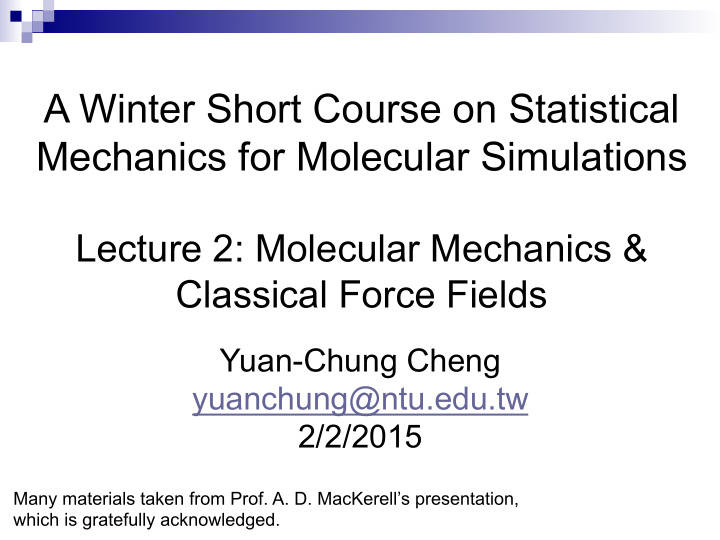



A Winter Short Course on Statistical Mechanics for Molecular Simulations Lecture 2: Molecular Mechanics & Classical Force Fields Yuan-Chung Cheng yuanchung@ntu.edu.tw 2/2/2015 Many materials taken from Prof. A. D. MacKerell’s presentation, which is gratefully acknowledged.
The Molecular Hamiltonian In atomic units: 1 Hartree = 27.2114 eV = 627.509 kcal/mol
Solving this is a huge part of molecular simulation in chemistry (i.e. quantum chemistry), but this is not the topic that I will pursue.
Potential Energy Surface n QM calculations yield potential energy surface that governs nuclear motions E ( R ) = Ψ H elec Ψ Determines reactions/thermodynamics/ … Multidimensional Complex
Potential Energy Surface n Large systems – complex energy landscape, many degrees of freedom, à full quantum all-electron calculations become infeasible!! n We need simple classical models n No need for all the details, anyway … Protein folding funnel The curse of dimensionality!!
2013 !年諾貝爾化學獎 ! ! n 2013 Nobel Chemistry Prize jointly to Martin Karplus, Michael Levitt and Arieh Warshel "for the development of multiscale models for complex chemical systems" . n 複雜系統多層級計算方法的建立 n 將化學實驗帶入電腦時空 Martin Karplus Michael Levitt Arieh Warshel Pictures from nobelprize.org Slide from Prof. Jhih-Wei Chu 6
Very informative read! Michael Levitt’s Nobel Lecture
General Considerations n Description of molecules? n Optimization of force field parameters? n Training set of compounds/data? n Test set of compounds/data? n Limitations – questions you should not ask of your force field
Common All-Atom Force Fields n Class I: Standard structural terms CHARMM, CHARMm (Accelyrs), AMBER, OPLS, ECEPP, GROMOS, SYBYL (Tripos) n Class II: Standard + cross terms CFF95 (Accelrys), MM3, MMFF94, UFF n Class III: Non-additive, polarizable terms QM/MM, Polarizable FF - Freisner/ Berne(Schroedinger), AMOEBA (Tinker) They are different!!! So parameters from one cannot be used in another force field.
The Urey-Bradley term captures the influence of the stretch-stretch and stretch-bend coupling terms on vibrational frequencies. It is not included in class II force fields (Amber/GROMOS, do you know why?). See Norman Allinger, Molecular Structure: Understanding Steric and Electronic Effects from Molecular Mechanics.
LJ-9-6 Buckingham
Taken care of via nonbond list
Construct New Force Fields
Needs new parameters
Molecular Mechanics n Simplest type of calculation ¨ Used when systems are very large and approaches that are more accurate become too costly (in time and memory) n Does not use any quantum mechanics instead uses parameters derived from experimental or ab initio data ¨ Uses information like bond stretching, bond bending, torsions, electrostatic interactions, van der Waals forces and hydrogen bonding to predict the energetics of a system ¨ The energy associated with a certain type of bond is applied throughout the molecule. This leads to a great simplification of the equation n It should be clarified that the energies obtained from molecular mechanics do not have any physical meaning, but instead describe the difference between varying conformations (type of isomer). Molecular mechanics can supply results in heat of formation if the zero of energy is taken into account. Courtesy of Shalayna Lair, University of Texas at El Paso
OTHER ISSUES Solvation, electrostatics …
Solvation Models
Born Model n Solvent modeled as continuum dielectric medium n Solvation free energy of q a charge easily calculated n No molecular details, assumes instantaneous solvant relaxation … n Can be generalized …
Born Model n Solvent modeled as continuum dielectric medium n Solvation free energy of a charge easily calculated n No molecular details, assumes instantaneous solvant relaxation … n Can be generalized … https://chemistry.osu.edu/~herbert/projects/PCM.html
Explicit Solvent Model Long range electrostatic interactions can be troublesome!
Ewald Sum Particle-mesh Ewald: combine short-range cut-off and FFT for long-range part on a mesh.
Recommend
More recommend